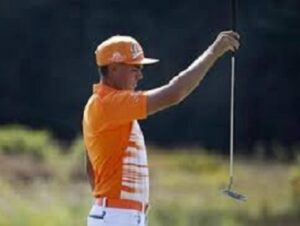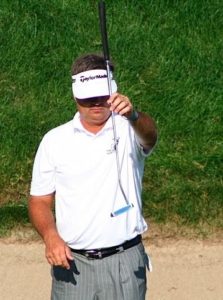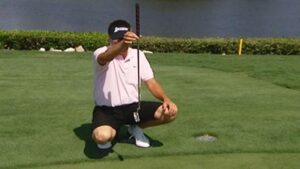Missing a putt by 1 inch is just as bad as missing it by a foot. If you can’t read the break near the hole, you will never make those 3 footers or those 10 footers. The best way to lower your score is to cut your number of putts as they count for almost half of your strokes on every round of golf. .
Our blog released August 20, 2018 covered the important rules for putting. We also mentions using your putter as a Plumb-Bob (PB) to determine the break for your putts. I have received so many requests to clarify PB that I decided to explain the 2 important factors for PB: Calibrate Your Putter and PB only measures the angle of the slope where your putter is hanging from your hand.

I couldn’t find an image with Justin Rose but here is Rickie Fowler Plumb Bobbing incorrectly (I suspect) from behind the his ball.
Special NOTE to Justin Rose
I often see Justin Rose and other professional golfers on TV using their putter as a plumb-bob to determine the slope of the green. They are wasting their time trying to PB from behind their ball because they are only measuring the slope where they are standing.
ONLY PLUMB-BOB A PUTT NEAR THE HOLE IF YOU REALLY CAN’T TELL THE SLOPE OF THE GREEN NEAR THE HOLE. The most break occurs as your ball slows down at the hole, so plumb-bobbing by standing on a line from behind the hole to your ball is the most important slope that you should be measuring. Of course the changing slope that you see on your putting line to the hole is also important as it will throw your ball in different directions as it roles along that path. Always check the changing slope by observing it from the low side of the slope to estimate the impact on your putt line.

This is a good shot of Kenny Perry. I hope his putter was calibrated to drop straight down when the face is pointing at the hole.
1/ Calibrate Your Putter
Every putter head is weighted differently and is attached to the shaft differently so the putter will not always hang perpendicular to the ground. If you don’t determine your correct eyeball and the correct direction to face your putter when it is perfectly perpendicular to the earth, you should NOT EVEN TRY to use your putter to plumb-bob.
Inside a building hold your putter with 2 fingers in front of you and close ONE of your eyes as you line up the straight line of ONE SIDE of the shaft of your tapered putter shaft with a door frame about 6 to 10 feet away from where you are standing. Try turning the putter and changing your open eye to determine the PERFECT MATCH to line up THE LEFT OR RIGHT SIDE of the shaft with the door frame. [In my case I use my right eye (left eye is closed) and position my putter face directly at the door and only line up with the left side of my putter shaft.] You have to remember: 1/the eye, 2/the direction of the putter face and 3/ the side if the putter shaft to use every time you PB. [Don’t include the grip as part of the putter shaft.]

Not sure who this is but it is a great idea to get close behind the hole and down low to see if your putter shaft end up left or right of the ball to find the HIGH SIDE OF THE SLOPE near the hole.
2/PB to Determine the Break at the Hole:
Make sure that the slope on your putting line behind the hole is similar to the slope at the hole. Stand about 3 to 5 feet behind the hole and visually line up the hole with your ball [without using your putter]. Then hold your putter up, to line-up with the hole at the BOTTOM of your shaft. If the top end of your shaft ends up on the left or right side of your ball then that is the high side of the slope. Your ball will curve down from that side of the green as it slows down near the hole.
Would someone please pass this blog to Justin Rose and ask him to call me if he doesn’t understand this. Don’t forget to practice putting with a flat leading wrist straight up your putting line for consistency using your GOLFSTR+ . Buy one today at www.golfstr.com



[…] Get the Right Read & Sink More Putts ! […]
[…] Source link […]
I have said and written repeatadly that plumbbobbing is the worst way to assess a slope on the green:it’s a flawed method from the beginning on and it can be demonstrated why .
Amongst the many existing methods ,I myself use two which are reliable :use your feet and your sense of balance when walking along the line ;and most importantly from 5 feet from the hole
Look at the inside of the hole from above it to find which part is covered by grass and which is not .Then look a t the landscape ,where are the hills ,where is the water ,where is the sun setting
Thanks for your comments. There are too many pro golfers and senior pro golfers using plumb bobbing with their putters to ignore it. I can’t imagine that you can feel a 1 degree of slope by walking the line of your putt but I’m glad to share you successes.
I realize that there has been a lot written about plumb bobbing with a putter but a lot of it is hogwash. As an engineer, I know that you are only measuring the slope under your feet with a reference to the line of your putt. If you do this from the hole looking back to your ball, you will get a great feel for the slope near the hole (where your ball breaks the most as it slows down).
I can attest that plumb bobbing absolutely, positively works 99 percent of the time for me. I think it is hogwash that anyone – even the pros – but certainly amateur and high handicap golfers can ascertain the true line on long puts by looking at them. At best it is guesswork in my opinion. Of course I check the cross slope if not dead flat and also check if uphill, level or downhill but the plumb bob gives me my line. So I ‘ll keep on plumb bobbing as the most reliable way to get the line
Hi Gavin, Glad to hear that you get it. Many don’t understand that you are actually measuring the slope directly under your feet with respect to the hole. I have seen golfers like Justin Rose plumb Bobbing from behind the ball to the hole and the odds of that slope being the same as the slope at the hole could be 50/50.
Are you in South Africa? I have another avid reader from Monte Carlo. Love to hear from readers around the world.
Will Curry
Hello Will, Thank you for your comments. Yes I live in SA – Somerset West near Cape Town and am a member at Erinvale GC. Yes we are measuring the slope under our feet but especially on shorter putts – say up to 12’ slope is normally fairly constant from ball to hole. But even on longer putts and with slopes sometimes going both ways on longer putts, the plumb bob method will hopefully get me close enough to 2 putt provided my strength is right. Using this method I rarely miss a short putt Regards. Gavin
Thanks Gavin, you are right on! Too many golfers disagree with Plumb Bobbing because they see people like Justin Rose doing it incorrectly. The most important part of PB is understanding the break at the hole where your ball is slowing down and making the most break. Greens often have multiple breaks and you have to try to read all of the breaks. But the most important break is the last one near the hole. BTW if you can see wild breaks on the green, don’t waste your time PBing. Just do your best to estimate the break. PB if what you need to do when YOU CAN’T SEE THE BREAK AS YOUR BALL APPROACHES THE HOLE.
If you don’t calibrate your putter by lining up with a door frame, you should not try PB. Calibration and then understanding the concept of PB are 2 steps that everyone has to learn.
100 percent Will. PB is a waste of time if the putter does not hang vertically.
I have an engineering degree so it is easy for me to sort out the logic for PB. Many of our readers can’t grasp the concept. Thanks for your confirmation that PB works [especially when there is a slight slope at the hole where you need some confidence to help you with the reading].
Remember that a slight side slope at the hole can be overcome by a little more speed of the putt. Getting it right is the magic of golf. Slope angle and ball speed will only work if you get it right. The pros get it right more often than the rest of us and that’s why we love to watch the pros on TV.
Interesting to see that most pros don’t PB. Watching the Scottish open last weekend I could not help thinking that if Tommy Fleetwood had PBed the 16th and 18th he could have sunk the short putts and been the champion?
I agree that pros using PB incorrectly must be driving others away from using PB. Justin Rose has stopped using PB and his standings have dropped significantly as he has no idea where to target his putts. Good catch on Tommy. I missed that but I don’t know how to wake up the professional golfer and the recreation golfers to this wonderful technique.
There is no perfect putting solution but PB certainly can tell you which direction your ball will roll as it slows down near the hole.
Watching the golf in Portugal and Italy, I find it incredible that many of the pros continue to miss putts as short as 2 feet. PBing would definitely, if nothing else, confirm the break, and give them the confidence to make the putts.
I agree and thanks for your continued reminders. Knowing that there really is a break at the hole is the first step in building confidence in your putt (especially for your shorter putts) as longer putt will still change direction with the changing slope as your putt progresses toward the hole. Step #2: A MINOR slope across the hole on a 2 foot putt should be handled with a firm putt into the hole (do it with confidence to the high side but don’t aim your putt outside the hole). A 2 foot putt with a MAJOR slope does not need to be Plumb Bobbed. Don’t waste you time as you can see the slope and you will only make the putt using your past experience to make that putt with the down-hill and side-hill putts that you have faced in the past. Recall your past success and go for it with confidence. A stubbed putt will never go in the hole.